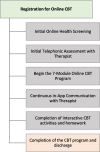Cognitive Behavioural Therapy to Optimize Post-Operative Fracture Recovery (COPE): protocol for a randomized controlled trial
- PMID: 36273187
- PMCID: PMC9587572
- DOI: 10.1186/s13063-022-06835-3
Cognitive Behavioural Therapy to Optimize Post-Operative Fracture Recovery (COPE): protocol for a randomized controlled trial
Erratum in
-
Correction: Cognitive Behavioural Therapy to Optimize Post-Operative Fracture Recovery (COPE): protocol for a randomized controlled trial.Trials. 2023 Feb 24;24(1):142. doi: 10.1186/s13063-022-06889-3. Trials. 2023. PMID: 36829243 Free PMC article. No abstract available.
Abstract
Importance: Chronic, non-cancer pain affects approximately 20-30% of the population in North America, Europe, and Australia, with surgery and trauma frequently cited as inciting events. Prospective studies of fracture patients have demonstrated an association between somatic pre-occupation, poor coping, and low recovery expectations following surgery with persistent pain, functional limitations, and lower rates of return to work. Psychological interventions, such as cognitive behavioural therapy (CBT), that are designed to modify unhelpful beliefs and behaviours have the potential to reduce persistent post-surgical pain and its associated effects among trauma patients.
Objective: To determine whether online CBT, versus usual care, reduces the prevalence of moderate to severe persistent post-surgical pain among participants with an open or closed fracture of the appendicular skeleton.
Design, setting, and participants: The Cognitive Behavioural Therapy to Optimize Post-Operative Fracture Recovery (COPE) protocol will be followed to conduct a multi-centre randomized controlled trial. Participants undergoing surgical repair of a long bone fracture will be randomized to receive either (1) online CBT modules with asynchronous therapist feedback or (2) usual care. The primary outcome will be the prevalence of moderate to severe persistent post-surgical pain over 12 months post-fracture. Secondary outcomes include the Short Form-36 Physical and Mental Component Summary scores, return to function, pain severity and pain interference over 12 months post-fracture, and the proportion of patients prescribed opioid class medications (and average dose) at 6 and 12 months post-fracture. The COPE trial will enroll 1000 participants with open and closed fractures of the appendicular skeleton from approximately 10 hospitals in North America.
Discussion: If CBT is effective in improving outcomes among patients with traumatic fractures, our findings will promote a new model of care that incorporates psychological barriers to recovery.
Trial registration: ClinicalTrials.gov Identifier: NCT04274530. Registered on 14 February 2020.
Keywords: Chronic pain; Cognitive behavioural therapy; Orthopaedic; Persistent pain; Randomized controlled trial; Trauma.
© 2022. The Author(s).
Conflict of interest statement
JWB is funded, in part, by a CIHR Canada Research Chair in the prevention and development of chronic pain.
Figures
References
Publication types
MeSH terms
Substances
Associated data
Grants and funding
LinkOut - more resources
Full Text Sources
Medical




